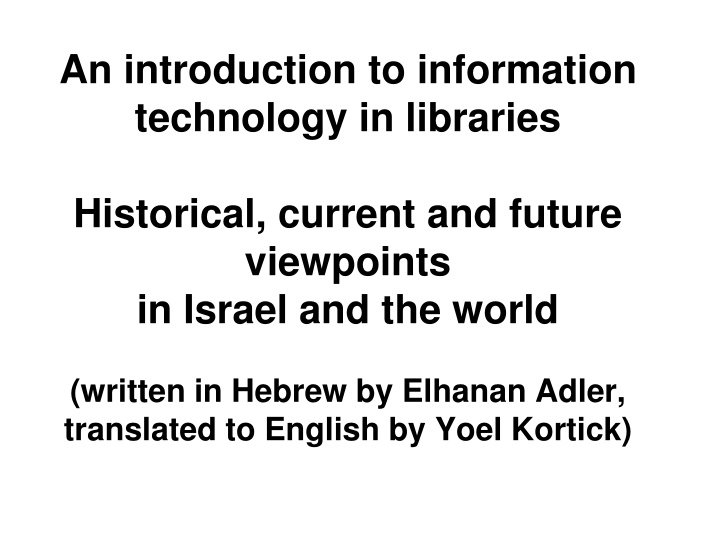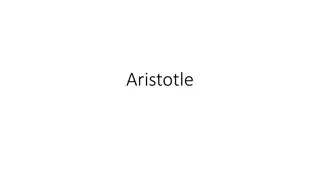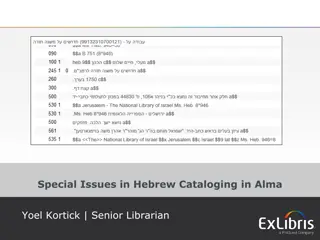
Information Technology in Libraries: Historical and Future Perspectives
Explore the evolution of information technology in libraries, including the implementation of computerized systems, cataloging advancements, and the role of leading institutions in Israel. Learn about key developments such as the MARC standard, online catalogs, and software innovations for bibliographic management.
Download Presentation

Please find below an Image/Link to download the presentation.
The content on the website is provided AS IS for your information and personal use only. It may not be sold, licensed, or shared on other websites without obtaining consent from the author. If you encounter any issues during the download, it is possible that the publisher has removed the file from their server.
You are allowed to download the files provided on this website for personal or commercial use, subject to the condition that they are used lawfully. All files are the property of their respective owners.
The content on the website is provided AS IS for your information and personal use only. It may not be sold, licensed, or shared on other websites without obtaining consent from the author.
E N D
Presentation Transcript
An introduction to information technology in libraries Historical, current and future viewpoints in Israel and the world (written in Hebrew by Elhanan Adler, translated to English by Yoel Kortick)
Computerized automated separate systems (circulation, acquisition, cataloging) Computerized automated systems for librarians, not for the end user Cataloging as "a smart word processer" for creating the catalog and an online catalog The MARC Machine Readable cataloging standard for the transfer of bibliographic information (1966) A fixed and continuous export of records in MARC format by the Library of Congress (1968) The establishment of OCLC ) Center and later Online Computer Library Center "Ohio College Library 1967 (
And in Israel two leading institutions: 1.The National and University Library 2.University of Haifa
The creation of the Index of Hebrew Periodicals (IHP) (1977) Computerized automated circulation (1980) Software for entering cataloging information (ORICAT) and the creation of cataloging cards (1981). Used by the Technion, Bar Ilan and Ben Gurion universities. Management of the MARC database and retrieval of cataloging records (a project which was transferred from Rafael) The HOBITS software for the management of bibliographic databases (Haifa Online Bibliographic Text System)
The Mini PDP 11/40 computer The Micro Computer Superbrain
The Technion Catalog on microfiche ( created by U. of Haifa) ( 1982 )
The combining of several library functions into one system: Integrated Library System OPAC Online Public Access Catalog Local development by leading Universities or by networks The beginning of the marketing of "ready to use" software, some of which grew out of local systems (VTLS, NOTIS, DOBIS, ALEPH)
Aleph version 1 a centralsystem on one central computer CDC Aleph version 2 a decentralized system on a mini computer with VMS operating system Aleph 300 - An advanced version of Aleph 2. VMS and Unix operating system. Developed and marketed for the European market. Aleph 500 - An innovative and new system using Unix and Oracle. Developed and marketed for the American market.
1. The creation of a National Bibliographic Catalog Members of the council see this as important for the use and sharing of by the University Libraries. This will be established *outside* (stressed in the original) of the existing universities and will be functionally independent. Ata a later stage the universities will be able to utilize the services of this catalog. 2. All university libraries will be connected to this central catalog via terminals using telephone lines. .... 4. The catalog needs to be based on MARC, and immediately there needs to be the creation of a Hebrew MARC .... 6. The members of the committee recommend the creation of an in depth report on the need of the catalog and how it will be applied.
Survey done by IBM (1980) Recommendation: The development of Aleph instead of purchasing DOBIS/LIBIS from IBM (1981) Both of them: A Central system - One large central computer and on central bibliographic catalog Alternative suggestion from the University of Haifa: progress in small steps with local smaller systems. The official committee for budget planning decided to go with Aleph, to support the development and encourage additional institutions to cooperate.
No agreed-upon decision regarding a single bibliographic database (even within the Hebrew University itself) A country wide communications network which was not reliable. (difficulties in testing between the Technion and Ben Gurion University) If in any case there will be separate bibliographic databases - why not separate the hardware and solve the problem of communications? Aleph 2 - an independent system for each institution (or part of institution - Hebrew University had separate computers for each campus) Encouraging the adoption of Aleph 2 by the committee for budget and planning - supporting the purchasing of hardware.
The beginning of Aleph Advertisement from the early 80 s (marketed abroad by AUREC) Terminal in picture: Elbit systems
The creation of unique local codes for cataloging Not using international MARC standards Too much allowing for local standards and configurations in the system The encouragement of being creative and doing local practices Lost a chance to establish a national bibliographic standard. A large part of the current issues are the results of the general atmosphere of those early years .
A problematic conversion / migration (especially for serials) Much of the development was abroad (Denmark) Partial and not really supporting MARC format Most of the libraries converted to MARC during Aleph 300 and did so as part of the conversion process of Malmad. This allowed to cover the gaps in different ways libraries work and establish some uniformity (though there still existed local creative workflows).
A completely different system Worked on UNIX and not VMS Database using SQL and ORACLE Uses Unicode instead of ASCII Client server architecture OPAC is web based Not all Israeli institutions succeeded in reaching the same technical level as they did with Aleph 300.
The combining of resources for the betterment of the libraries There are numerous examples abroad of consortia using Aleph for several institutions (with different models) There is an unwillingness of the Universities to use Aleph within a consortium The colleges made a correct decision to go with a consortium. Even if there are other issues it is still the right decision.
Public interfaces which bring together data from several different sources. For example: Primo, Aquabrowser, WorldCat Local Back office systems which are more innovative and relevant for the current and future information world Basing catalogs on shared bibliographic databases SAAS and Cloud computing Interesting development - OCLC entering the area of local ILS systems Returning to the ideas of a central system from 30-40 years ago!
And small and midsize libraries in Israel From 1983 on there were local systems based on a PC (DOS and then later Windows) Originally designed for the librarian and then later for the end user. Web versions Central systems today: Sapir, TOP, Sifrat, Agron, Alei Kotarim and more A trend towards hosted systems






















